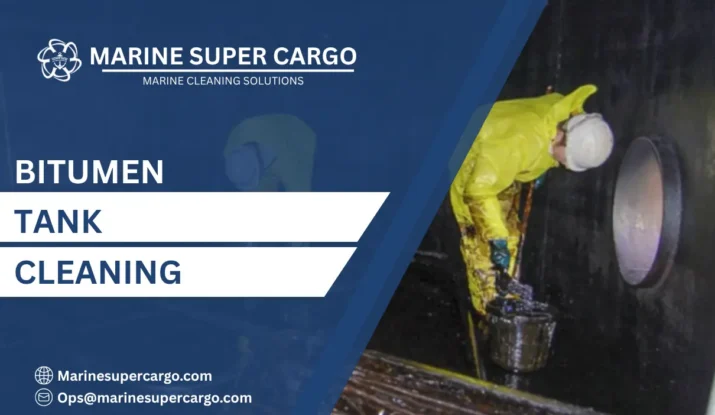Bitumen transportation presents unique challenges for vessel operators due to the cargo’s extreme viscosity and adhesive properties. Bitumen tank cleaning requires precise temperature management and strategic solvent application to achieve acceptable cleanliness standards. Without proper procedures, bitumen residues harden into immovable deposits that compromise cargo space integrity and violate operational requirements.
At Marine Super Cargo, we specialize in comprehensive bitumen tank cleaning services that address the complex nature of this demanding cargo. Our teams understand that effective bitumen tank cleaning depends on maintaining optimal thermal conditions throughout the operation. The combination of heat, appropriate solvents, and mechanical action ensures thorough residue removal from all tank surfaces.
Understanding Bitumen Properties
Bitumen consists of heavy hydrocarbons with viscosity ranging from 30 to 10,000 centistokes depending on grade. This petroleum-derived product adheres tenaciously to steel surfaces, penetrating into pitted areas and coating structural members throughout the cargo space. The bow and stern sections often harbor the most persistent deposits due to reduced circulation during loading and discharge operations.
Temperature dramatically affects bitumen behavior. At ambient conditions, bitumen becomes virtually immobile, making conventional cleaning methods ineffective. Successful bitumen tank cleaning requires sustained elevated temperatures that maintain the cargo in a fluid state throughout the entire operation.
Temperature Management Strategies
Pre-Heating Phase
Before commencing bitumen tank cleaning, the cargo space must be heated to minimum 80°C. This temperature ensures bitumen residues liquefy sufficiently for removal. Tank heating systems operate continuously during this phase, with particular attention to areas along the tank bottom where the heaviest deposits accumulate.
Heating coils positioned throughout the cargo space facilitate uniform temperature distribution. Thermal imaging surveys verify that all areas, including the forward and aft sections, achieve target temperatures before washing begins. Marine Super Cargo employs advanced heating techniques that optimize energy efficiency while maintaining required thermal conditions.
Maintaining Operational Temperatures
Throughout bitumen tank cleaning operations, temperatures must remain above 70°C to prevent re-solidification. Hot water systems deliver wash water at 85-95°C, ensuring thermal energy transfers to tank surfaces continuously. Temperature monitoring at multiple points confirms adequate heat maintenance across all cargo space areas.


Solvent Selection and Application
Aromatic Hydrocarbon Solvents
Specialized aromatic solvents dissolve bitumen residues effectively when applied at proper concentrations and temperatures. These formulations penetrate thick deposits, breaking molecular bonds that attach bitumen to steel surfaces. Solvent selection for bitumen tank cleaning considers cargo grade, residue thickness, and environmental regulations.
Solvent application proceeds systematically, treating the overhead, port and starboard bulkheads, and structural members sequentially. Adequate contact time allows chemical action to soften deposits before mechanical washing commences.
Biodegradable Alternative Solutions
Environmental considerations drive adoption of biodegradable cleaning agents for bitumen tank cleaning. These formulations meet MARPOL discharge requirements while delivering acceptable cleaning performance. Marine Super Cargo utilizes eco-friendly solutions that balance operational effectiveness with environmental responsibility.
High-Pressure Hot Water Washing
Following solvent treatment, intensive hot water washing removes liquefied bitumen from all surfaces. Butterworth machines positioned strategically throughout the cargo space deliver high-pressure streams that dislodge stubborn deposits. Water temperatures exceeding 85°C maintain bitumen fluidity during the washing cycles.
Multiple washing stages ensure complete residue removal from complex structural areas, heating coils, and tank bottom plating. The systematic approach proceeds from overhead areas downward, preventing cleaned surfaces from recontamination by falling debris.
MARPOL and IMO Compliance
Bitumen tank cleaning generates significant quantities of oily washings requiring proper management. MARPOL Annex I regulations govern retention and disposal of these wastes. All washings must be collected in slop tanks for subsequent discharge to reception facilities or processing through onboard equipment.
The IMO requires detailed documentation of cleaning operations, including methods employed, volumes generated, and disposal procedures. Vessels must maintain accurate Oil Record Book entries demonstrating compliance with international conventions. Port state control inspections scrutinize these records during routine examinations.
Ventilation and Gas Freeing
After washing completion, thorough ventilation removes hydrocarbon vapors and solvent residues from the cargo space. Forced air circulation continues until atmospheric testing confirms safe entry conditions. Oxygen content must exceed 21%, hydrocarbon concentrations remain below 1% LEL, and toxic vapor levels stay within permissible limits established by SOLAS requirements.
Safety Protocols and Personnel Protection
Slip hazards increase significantly during operations due to liquefied bitumen coating tank surfaces. Anti-slip footwear and secured working platforms prevent injuries. Marine Super Cargo maintains rigorous safety standards that protect personnel while ensuring operational efficiency.
Time and Resource Planning
Complete bitumen tank cleaning typically requires 48-72 hours depending on vessel size, cargo grade, and residue quantity. Adequate planning ensures sufficient fuel oil for heating systems, freshwater supplies, and disposal capacity at the discharge port. Efficient operations minimize vessel downtime while achieving required cleanliness standards.
Frequently Asked Questions
Q1: What temperature is required for effective bitumen removal?
Tanks must be heated to minimum 80°C before cleaning, with wash water temperatures maintained at 85-95°C throughout operations.
Q2: Can bitumen washings be discharged overboard?
No, MARPOL Annex I requires all oily washings be retained onboard for proper disposal at approved reception facilities.
Q3: How long does complete bitumen tank cleaning take?
Operations typically require 48-72 hours depending on tank size, bitumen grade, and required cleanliness standards.
Q4: Are biodegradable solvents effective for bitumen cleaning?
Yes, modern biodegradable formulations provide acceptable cleaning performance while meeting environmental regulations.
Q5: Why is continuous heating necessary during cleaning?
Bitumen solidifies below 50°C, creating immovable deposits that prevent effective cleaning without sustained elevated temperatures.
Partner with Marine Super Cargo for expert bitumen tank cleaning services that ensure vessel readiness and regulatory compliance.


